Not sure why or how to measure internal communication effectiveness? Learn why measuring internal communications in the workplace is non-negotiable and discover essential communication KPIs that every comms professional needs to know.
While everyone from internal communicators to marketers to advertisers likes to think “content is King”, we’d like to introduce the King’s advisor: metrics.
Despite the power of internal communication metrics, statistics show that 41 percent of businesses don’t know how to measure communication effectiveness. As a result, they have no KPIs for internal communications.
This means that nearly half of internal communicators have no hard data they can use to prove their value.
In this guide, we’ll show you best practices for internal communications measurement and break down the communication KPIs you need to know. We’ll also show you how internal comms measurement tools like ContactMonkey can help you easily identify best-performing content and show how well your content is performing to others.
Take a self-guided tour of ContactMonkey
See how our key features can streamline your internal communications.
Take product tour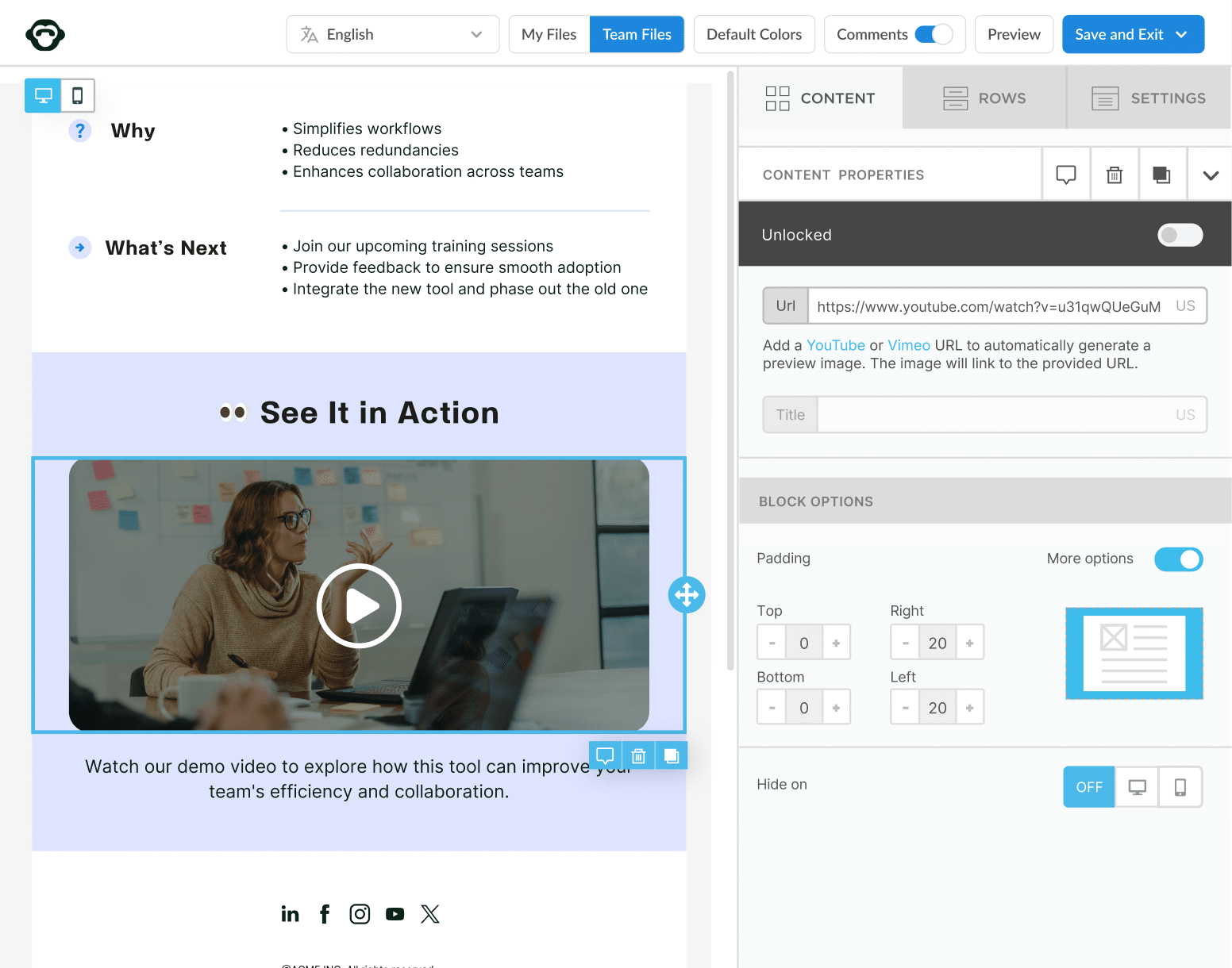
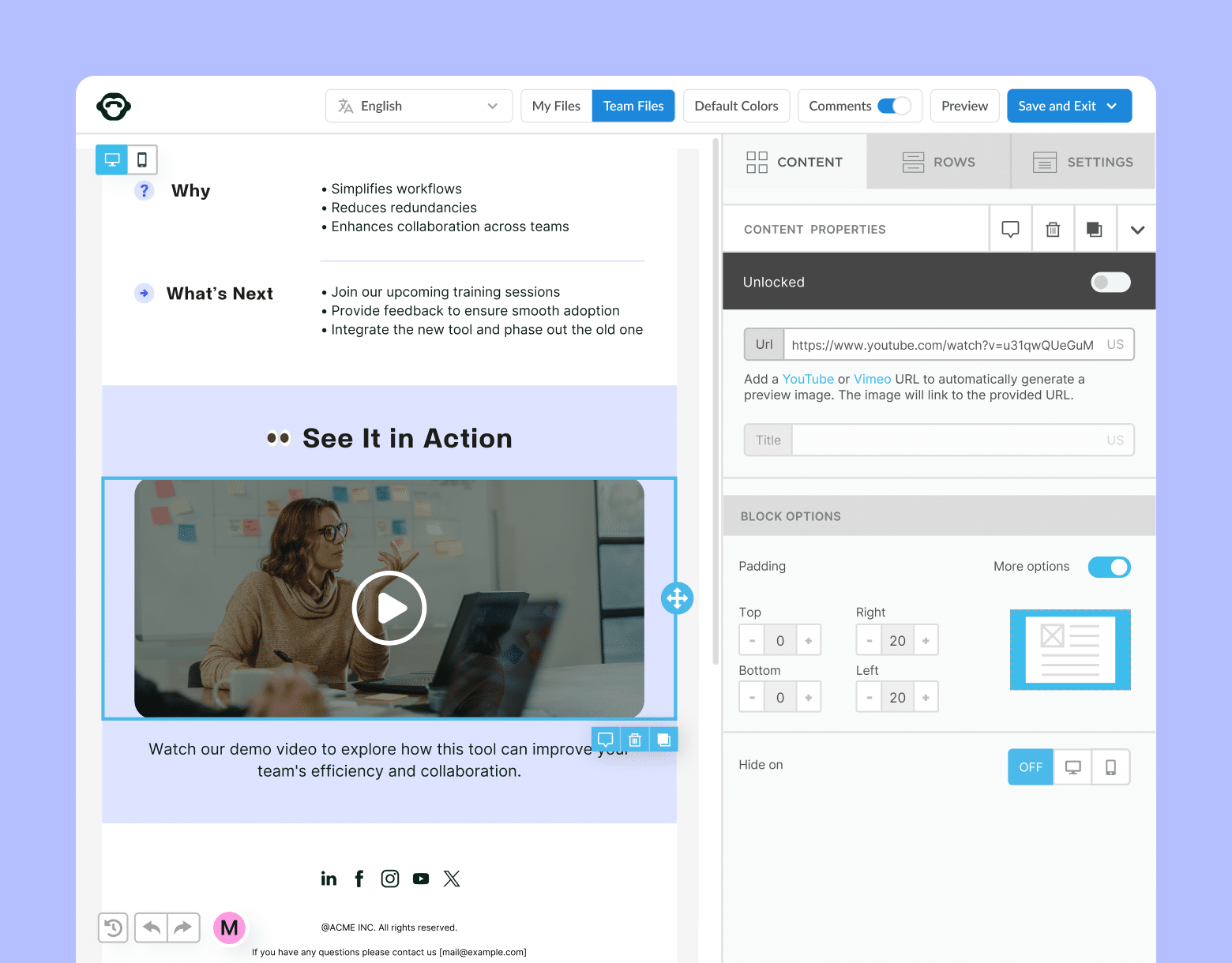
Why Track And Measure Internal Communications?
There are countless reasons why setting, tracking, and measuring your internal communications KPIS will benefit you and your business. But we’ve boiled it down to four simple reasons:
Prove your value
A key reason for measuring internal communication KPIs is to prove your value.
Every now and again you might find your internal communications budget under pressure. And it can be especially frustrating to feel as though you have to justify your salary. You’ll need to be able to speak the language of key performance indicators, especially when speaking with business leaders.
Measuring your success gives you the ammunition you need to prove your value to the organization.
Maximize your budget
On a similar note, measuring communication effectiveness can prove the ROI on internal communications and encourage greater investment.
A data-driven approach to internal communications will help you identify content that your employees crave. But just as importantly, it will help you avoid ineffective content strategies.
With measurable internal communications, you can be sure that your employees are engaging with your newsletter content. Take the guesswork out of internal communications, and start saving time today.
And if you’re having trouble getting budget approval, we’ve put together some templates that you can use for yourself.
Maximize time savings
While measuring internal communications effectiveness can take time to start, it will save you time in the long run.
By setting metrics for internal communications and keeping tabs on your internal communications efforts, it’s easier to prioritize which types of internal communications channels are worth your time. Long-term, that’s a game-changer.
You should also keep track of any time you spend clarifying and following up on each communication: if something is poorly explained it could result in dozens of follow-up calls or emails.
With Gmail and Outlook email tracking tools, like ContactMonkey’s internal communications platform, determining which content creates the most employee engagement couldn’t be easier.
Provide your employees with what they want to see the most by measuring your internal communications.
Watch ContactMonkey LIVE in action
Join live demo
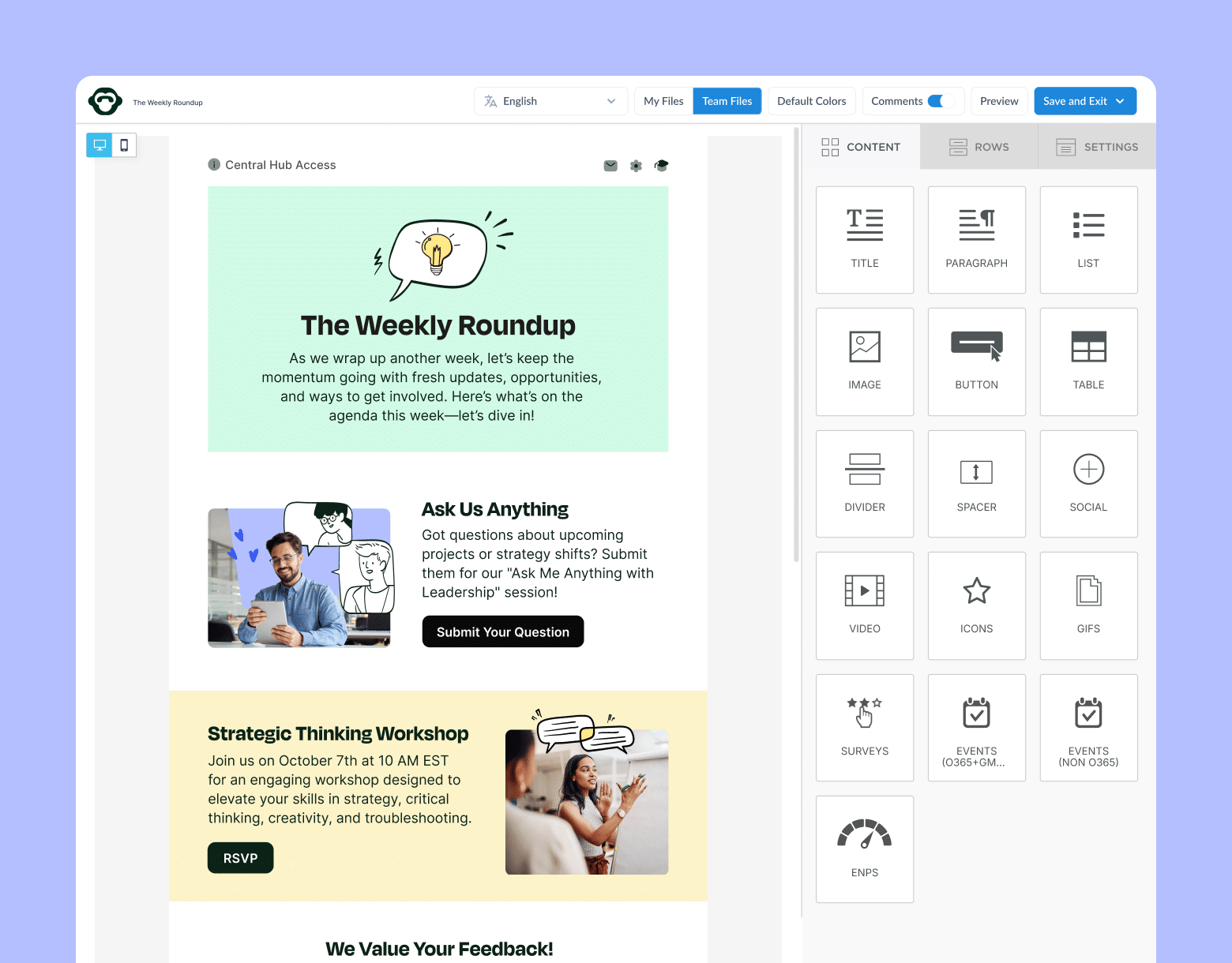
Improve communications quality and effectiveness
By tracking and measuring internal communications KPIs, you can build data-driven content to increase employee engagement.
Internal email analytics empower you to learn what truly engages employees. Whether it’s seeing which parts of an email employees scroll to the most through click maps, or how much time employees spend reading a message, data gives you powerful insights into your workforce.
Once you have these metrics under your belt, you can conduct an internal communications audit and begin developing a plan for improvement.
Let’s say you’ve noticed that deskless employees aren’t tuning into your email newsletters as much as other staff. You can begin to research remote employee communications tools, like internal SMS software, to amplify engagement.
Some analytics software even lets you get granular data and compare individual employee engagement with workplace engagement as a whole. ContactMonkey‘s analytics tool boasts both individual and overall tracking features. This allows users to dive into individual employee engagement trends as well as view aggregate data.
By separating individuals from the crowd, employers can create communications tailored to each member of their team. Or, inversely, they can decide when to send out mass employee notifications that will benefit everyone.
Pro tip: Create and send multilingual emails for internal communications with ContactMonkey. If more employees clearly understand the internal messages you send, then you have improved the quality and effectiveness of your communications!
How Do You Measure Internal Communication?
Measuring internal communications effectiveness starts with defining what exactly it is you’re measuring. There are many different types of analytics for internal communications and each serves a different objective.
For those who’ve ever wondered how to measure internal communication effectiveness, we’ve identified 11 key performance indicators (KPIs) that can help internal communication professionals measure and quantify the value of their work. The internal communication KPI examples can be broken down into a few categories: reach, engagement, and outcomes.
Below, we cover each of these essential KPIs for internal communications and dive deeper into how to measure communication effectiveness. We also list specific metrics for internal communications that you can use for internal comms measurement:
Internal Communication Metrics: Reach
Measuring internal communications metrics like reach determines how many employees are able to access your communication. This can help you identify how many of your employees are adopting your platforms, logging in regularly, and opening your communications.
Now let’s get into the internal communication KPI examples that best represent your reach.
Employee Adoption Rates for internal communications
Measuring Employee Adoption Rate is simple: calculate what percentage of employees have an account on a particular platform. The formula for Employee Adoption Rate is:

While Employee Adoption Rate can be insightful when comparing platforms, it doesn’t tell the entire story. Employee Adoption Rate analytics for internal communications are best used alongside the other reach metrics such as Log In Rate and Open Rate.
Log In Rate for internal communication platforms
Once you know how many employees have adopted a platform, the only real way to know if it’s engaging is to know how often your employees are logging in.
To calculate your Log in rate for a platform, you need to find out what percentage of employees with an account visit the platform on a regular basis. Most platforms should have these statistics available for admins. The formula for Log In Rate is:

Log In Rate can be very useful for determining the employee engagement trends of your recipients. For instance, it might be normal to experience a significant dip in Log In Rate in December when employees are frequently on holiday.
On the other hand, if you notice log in rates are steadily declining—in spite of seasonal trends—you may need to refresh engagement on your platform.
Obstacles to your Employee Adoption Rate include:
- Platforms with auto log-out
- Platforms that are not mobile accessible
- Platforms that aren’t relevant to your employees’ daily workflow
The only caveat when looking at Log in rate as a way of measuring internal communication effectiveness is that it doesn’t tell you the whole story. It doesn’t tell you who is looking at your content, only what percentage of your employees are eligible to see it.
Open Rate
Open rate is one of the most straightforward ways to start measuring internal communications effectiveness.
Just like it sounds, Open Rate measures what percentage of eligible employees are opening your internal communications. Usually, this means opening a newsletter or opening a blog post on your company intranet or a corporate wiki.
The formula for Open Rate is:

Open Rate is one of the most popular analytics for internal communications: it’s easy to understand and any email tracking tool worth its salt will make it very easy for you to access this metric. Need to determine how compelling your communications are? Open Rate is the metric you want. Determine what content your employees want to see the most, and then give it to them!
ContactMonkey’s internal communications metrics solution makes it ridiculously easy to measure email metrics like Open Rate and other useful measures of your email reach. Want to increase employee engagement using your internal communications? You could even try our new OpenAI integration to help you generate engaging copy, saving you time and effort.
Take a self-guided tour of ContactMonkey
See how our key features can streamline your internal communications.
Take product tour

Internal Communication Metrics: Engagement
Engagement metrics demonstrate how employees are interacting with your communications. These analytics for internal communications can help you identify:
- how many people are seeing your content;
- what people have to say about it;
- when they prefer to receive content;
- whether your remote team communication tools are effective
- how many employees would recommend working at your organization
Click-Through Rates
After sending your first newsletter to employees, you might take a look at your Open Rate and giddily report that everyone saw your email.
Not so fast!
Did they open your email, and then immediately close it? Or maybe they skimmed the email, but didn’t click on any links?
Click-Through Rate can apply to links and media in newsletters or blog posts. It determines who was engaged enough with your content that they wanted to learn more or take action.
The Click Through Rate formula is:

Click-through rates are extremely important internal communications metrics because they can inform you of gaps in your internal communication strategy (to identify other strategic shortcomings, be sure to check out our internal communication strategy checklist). If your Click Through Rate is lower than you would like, you can devise alternate strategies and mediums to help you achieve your desired engagement outcome.
ContactMonkey’s internal communications dashboard can help you see your click-through rate quickly and easily, along with other important internal communications analytics.
When you determine the peak times your recipients are most likely to engage with your emails, you can maximize your open rate and drive employee engagement through internal communication. Gathering data and understanding internal communications KPIs for internal communications is a surefire way to hone in on your best content.
You can even dive deeper by looking at Click Maps. Click Maps are a way to visually view how your readers are engaging with your content. You can see where readers are clicking and what call-to-actions are performing the best within emails you have sent out.
The more you review where your readers are engaging with your email content, the better you can tailor your emails to your readers’ needs and trends.
Responses and feedback
Wanna know a surefire way to know what your employees think about a business initiative?
Ask them; it’s that easy.
While other metrics can do a great job of showing how many people see and interact with your communications, direct feedback is the most accurate way to understand employee sentiment. Plus, the number of people taking the time to respond to your communications is a useful metric in itself.
Employee pulse surveys are important tools for measuring employee engagement, as they give internal communicators a snapshot of their employees’ feelings centered around a specific question. ContactMonkey has pulse surveys built into our drag-and-drop template builder, which makes it ridiculously easy to conduct a quick pulse check of your organization.
For even more qualitative internal feedback, you’ll want to make it easy for employees to leave you comments.
Sending newsletters from a third-party no-reply email address completely discourages any kind of two-way communication. Instead, try using an Outlook-native newsletter platform like ContactMonkey to collect employee comments directly from your regular newsletter!
When you make it easy for your employees to tell you what they think, you’ll find droves of measurable and actionable insights! That’s why we love using feedback as an internal engagement metric.
Learn how to create a successful employee newsletter with our step-by-step guide.
Get powerful email analytics and reporting features
Know exactly who is opening and engaging with your employee communications and company newsletters.
Explore analytics & reporting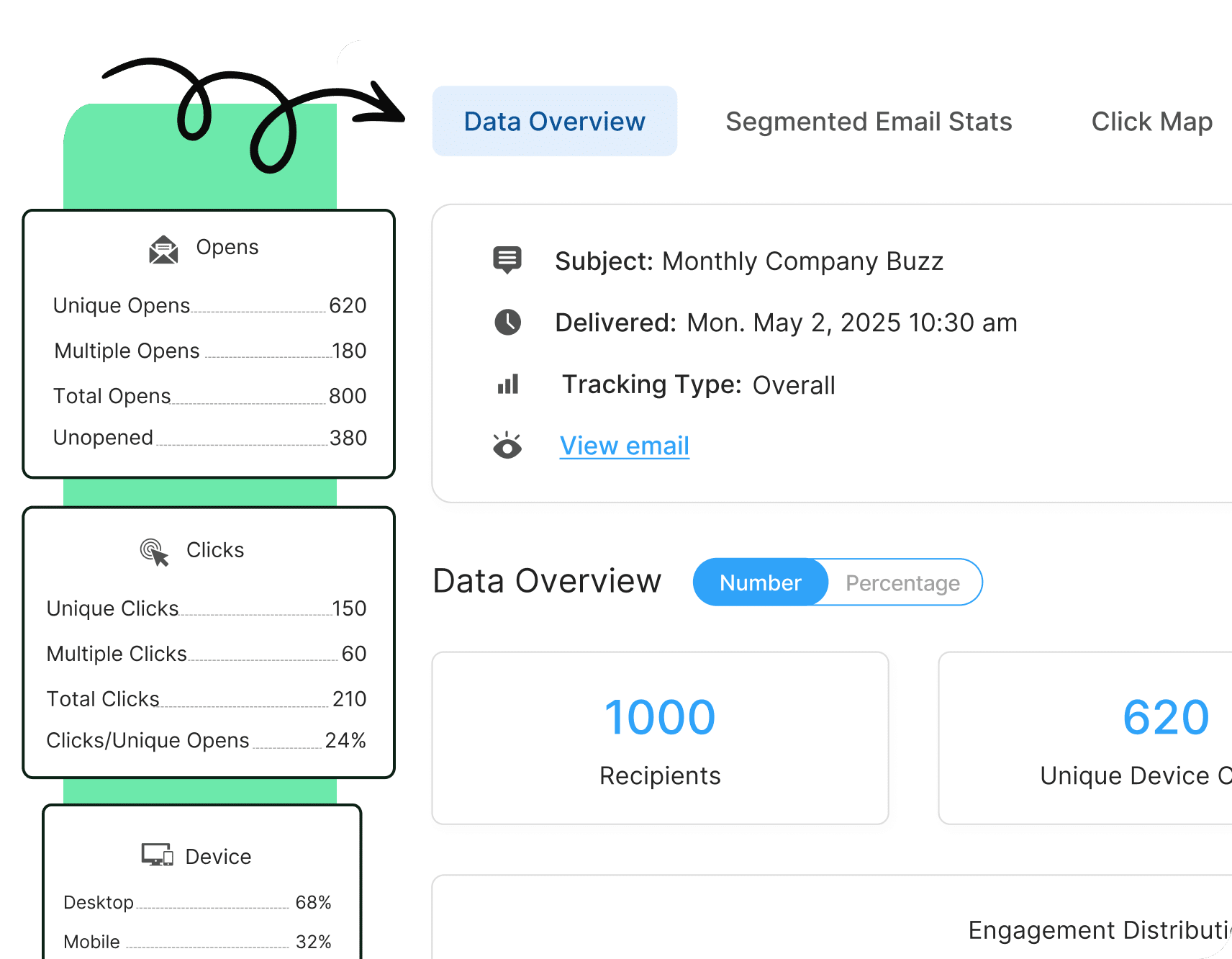
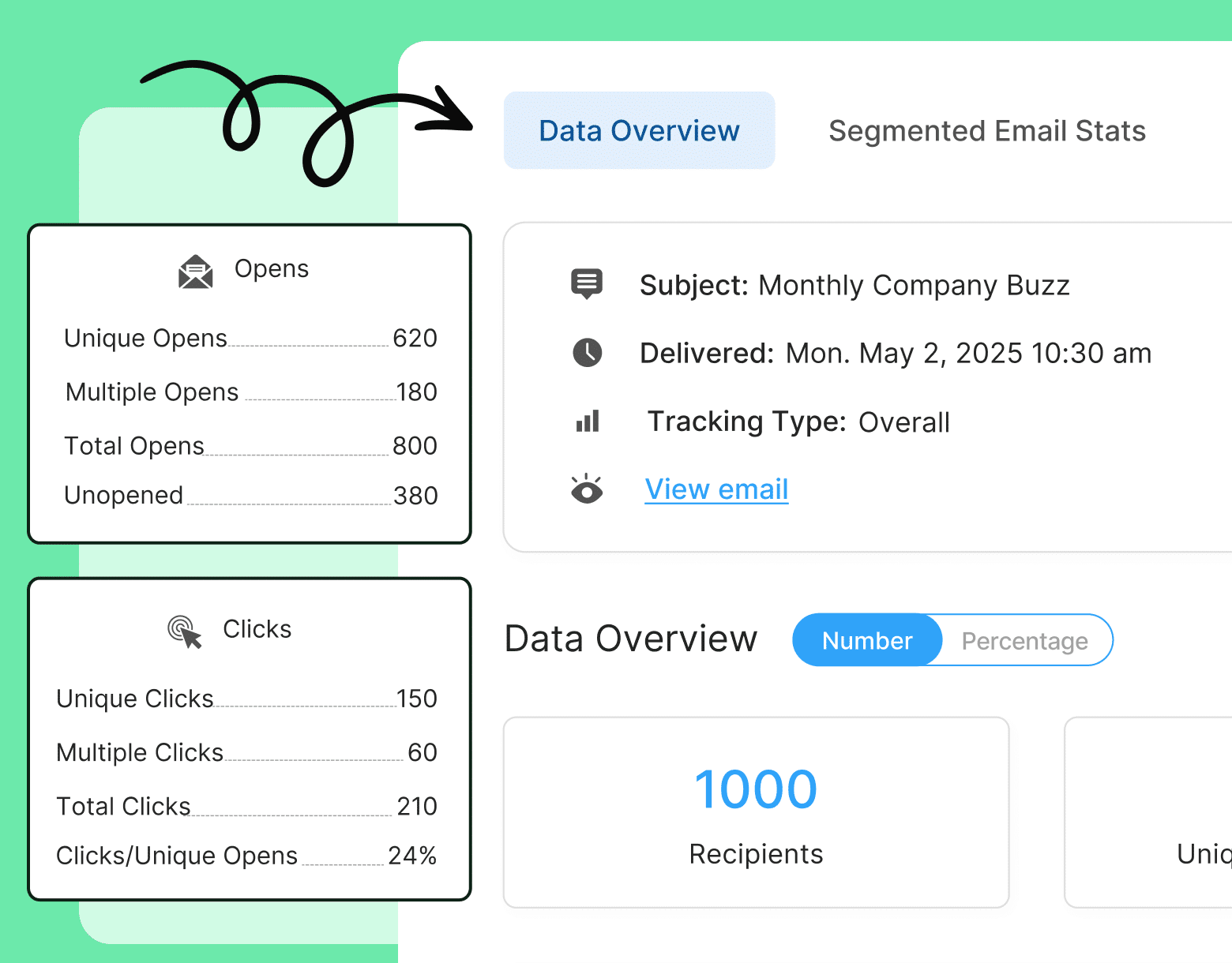
Demographic trends
The bigger your organization is, the more important it is for you to understand demographic trends within your company.
Age, location, and vocation could all affect your internal communications analytics and strategies. It’s critical to understand how these factors affect the adoption of platforms and the desired outcomes of your messaging. And with ContactMonkey, you can even segment your team into specific distribution lists for even more accurate results with easy-to-use internal email distribution list management features.
This is another employee engagement metric that doesn’t have a direct employee engagement ROIbut is invaluable for communicators looking to improve results in other key areas.
Peak times for employee engagement
Tracking the peak engagement times on your messaging can help you be strategic about when you’re sending communications. ContactMonkey helps internal communicators track when employees are engaging with their newsletters, and helps you schedule your newsletters so you’re never late for the peak engagement hour. When filling out your internal communications planning calendar, you can include send times to maximize your open rate.
Our number one tip for measuring peak engagement times is to make sure your newsletter distribution lists are segmented appropriately! This can help you target different divisions, cultures, and time zones in a way that maximizes your content creation efforts!
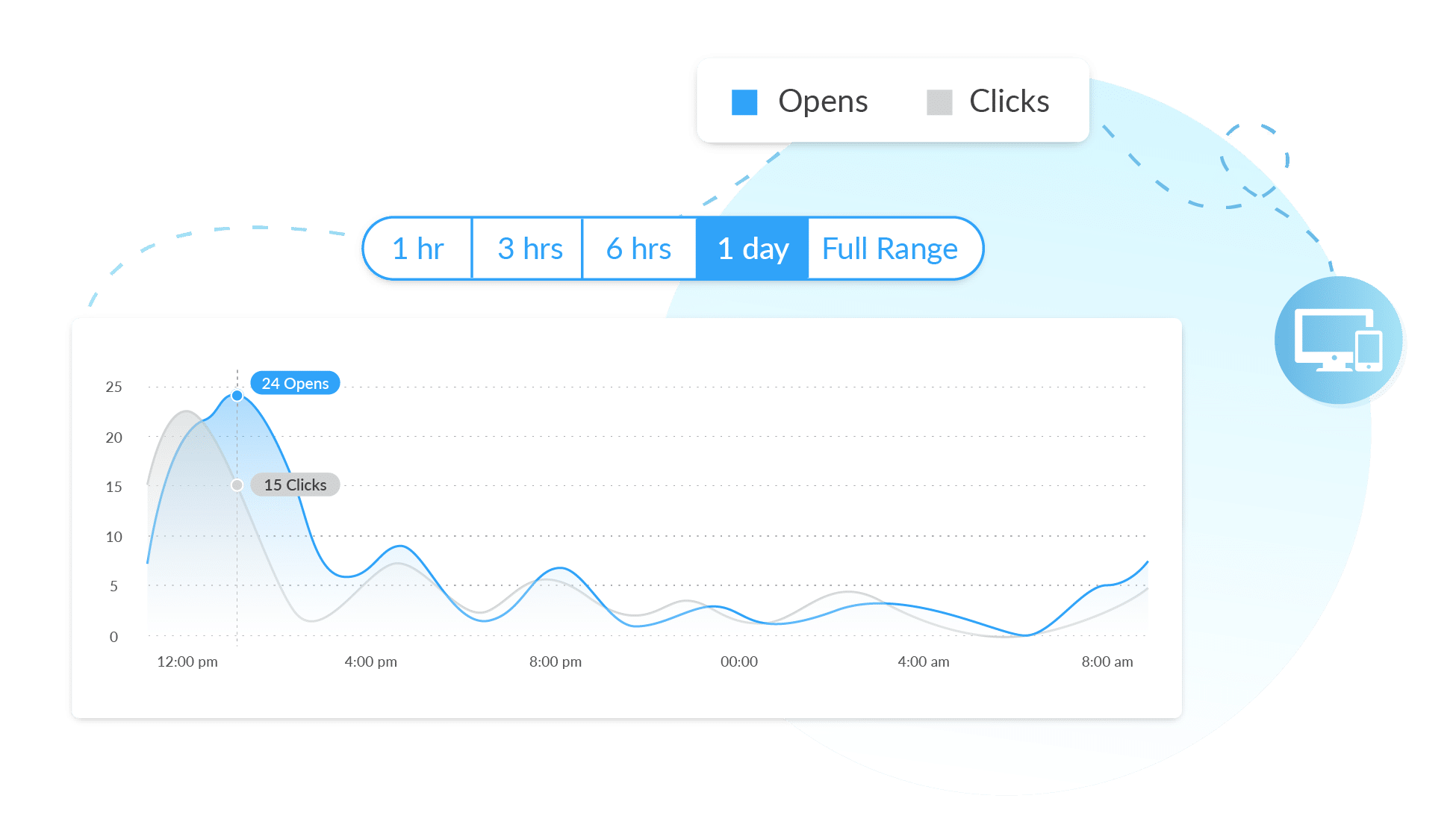
Click maps
Seeing which employee newsletters hit or missed the mark is great. But there’s something even more valuable: seeing what email content was responsible for the success (or lack thereof).
For a more granular look at internal communications engagement, you can use click maps to determine how your employees are interacting with your emails.
Click maps are a type of analytics for internal communications that shows you what parts of your employee email are sizzling and which parts are simmering when it comes to employee engagement.
ContactMonkey’s click map technology colour-codes the parts of your newsletter that attract the most attention and the least, as well as everything in between.
Say your monthly message from the CEO got the most clicks. In this case, it will be labeled red.
Now let’s say your open enrollment announcement link only got 1-2 clicks. If so, it will be labeled in yellow.
The colours in between – displayed through a legend – designate content that is getting medium engagement.
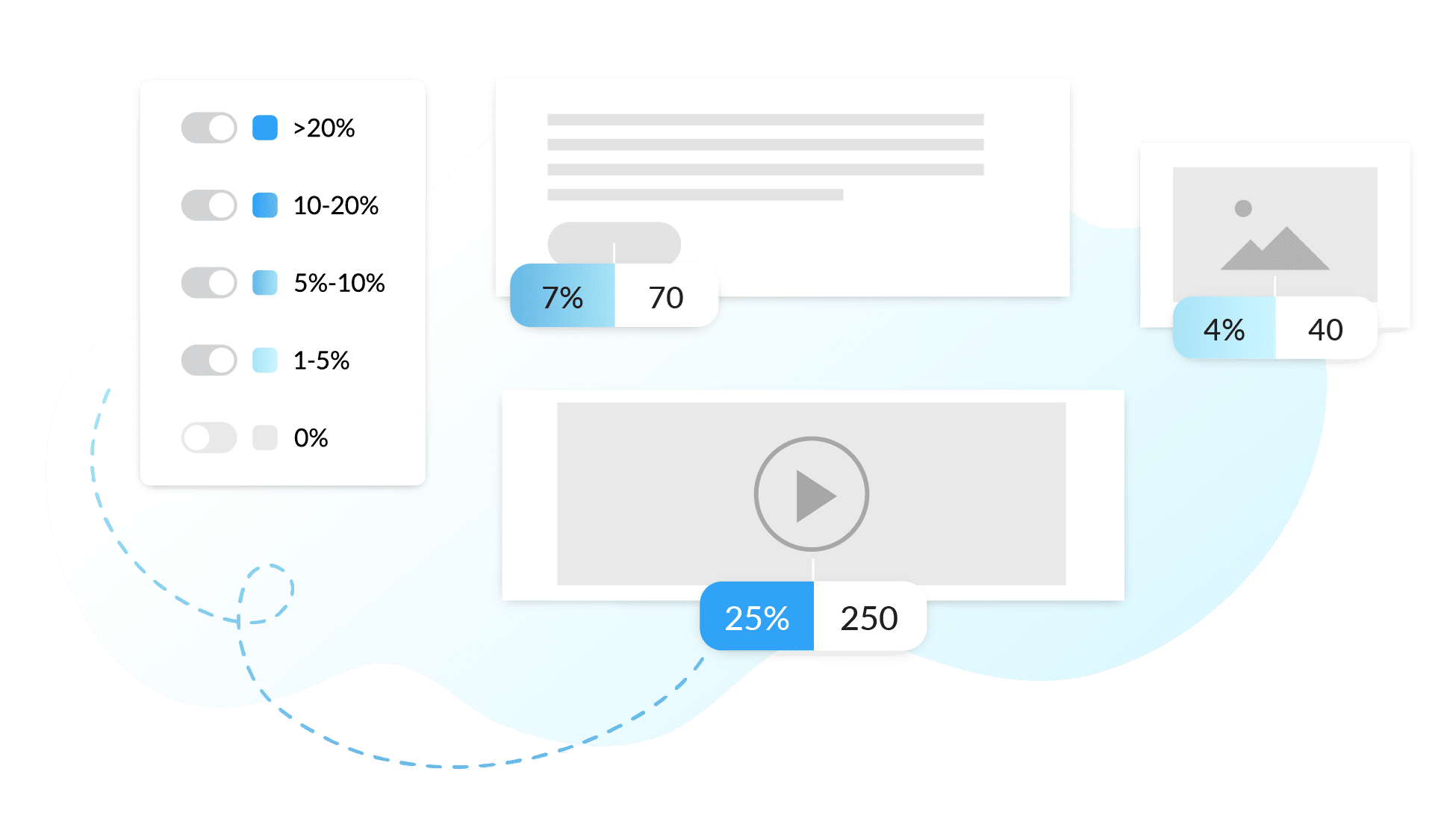
With this information, you can understand how your email design influences how your employees gather information from your emails, and then optimize your design to ensure your employees are seeing the information you need them to see.
Employee Net Promoter Score
Employee Net Promoter Score, or eNPS score, is one of the most reliable internal communication KPI examples. It measures how likely an employee is to recommend their workplace as a place to work.
These types of analytics for internal communications measure employee loyalty, as well as their likelihood to recommend your products and services. eNPS is an indispensable employee engagement metric because it gives you a good benchmark of the state of your workforce, and can be directly correlated with profitable outcomes.
Not only does higher eNPS correlate with lower turnover, it also indicates that your employees are working harder. Engaged and loyal employees aren’t just doing the bare minimum, they’re putting in their best effort. This is called discretionary effort, which disengaged employees are more likely to reserve for their personal lives. Employees who spend their discretionary effort in your company are going above and beyond.
To measure eNPS, all you need is a single, standardized question.
On a scale from 0-10, how likely are you to recommend this organization as a good place to work?
Answers are broken down between Detractors (0-6), Passives (7-8), and Promoters (9,10). Detractors and Promoters will be used to calculate your score. Neutral answers do not get factored into the occasion, because their net impact cannot be defined as negative or positive.
One of the main benefits of eNPS is that it is standard across all organizations, making it possible to benchmark your success against similar enterprises.
ContactMonkey’s template builder allows you to drag and drop an eNPS question into your internal communications KPIs. All of your employee’s feedback will be displayed on your Campaign Overview page.
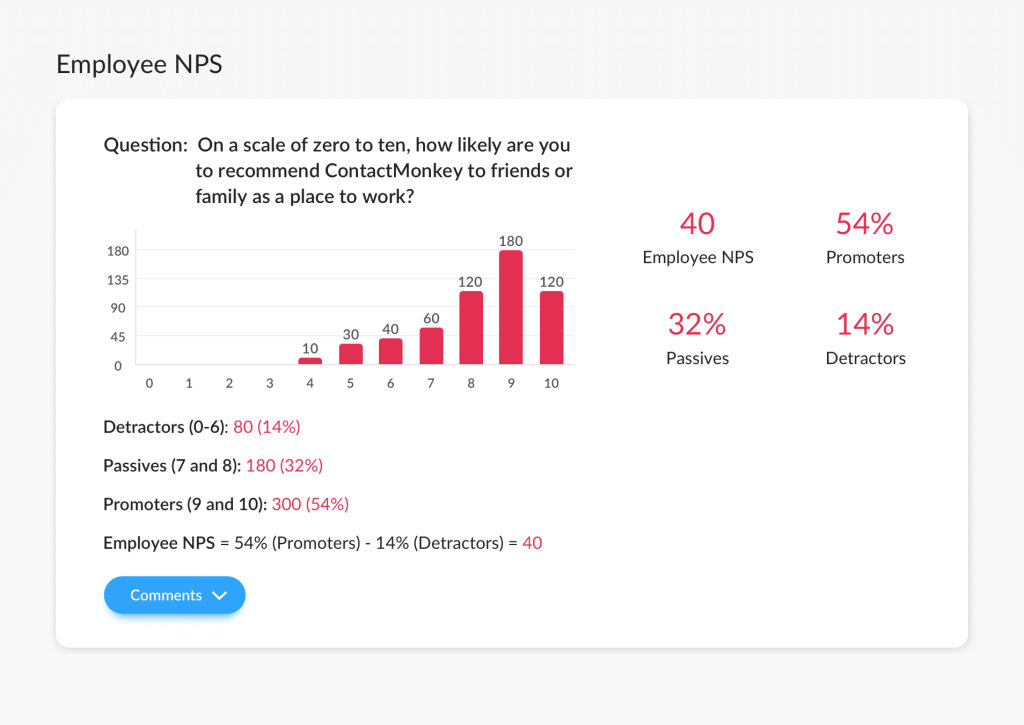
To get the most out of eNPS as an engagement metric, you should calculate it on a regular basis.
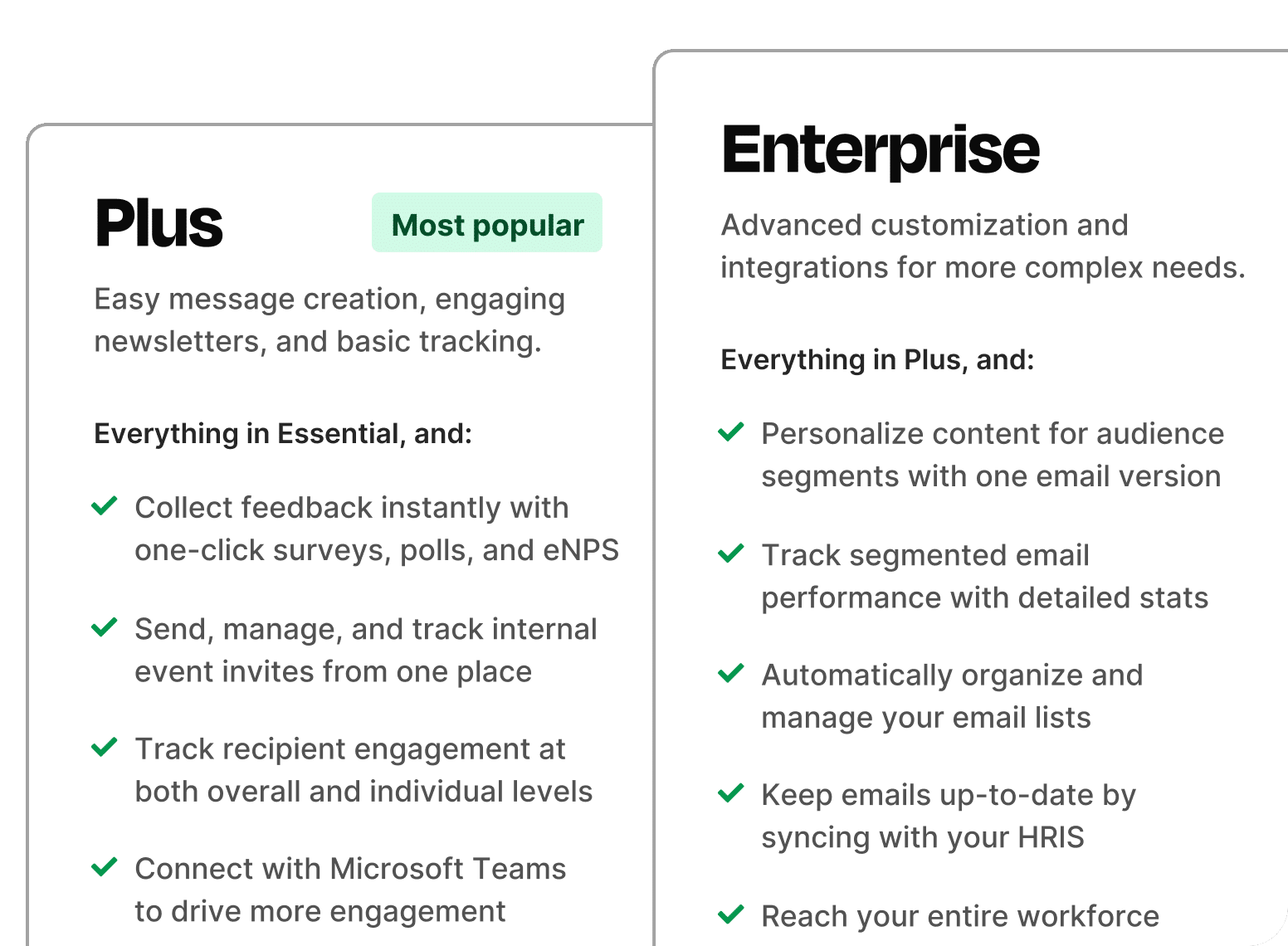
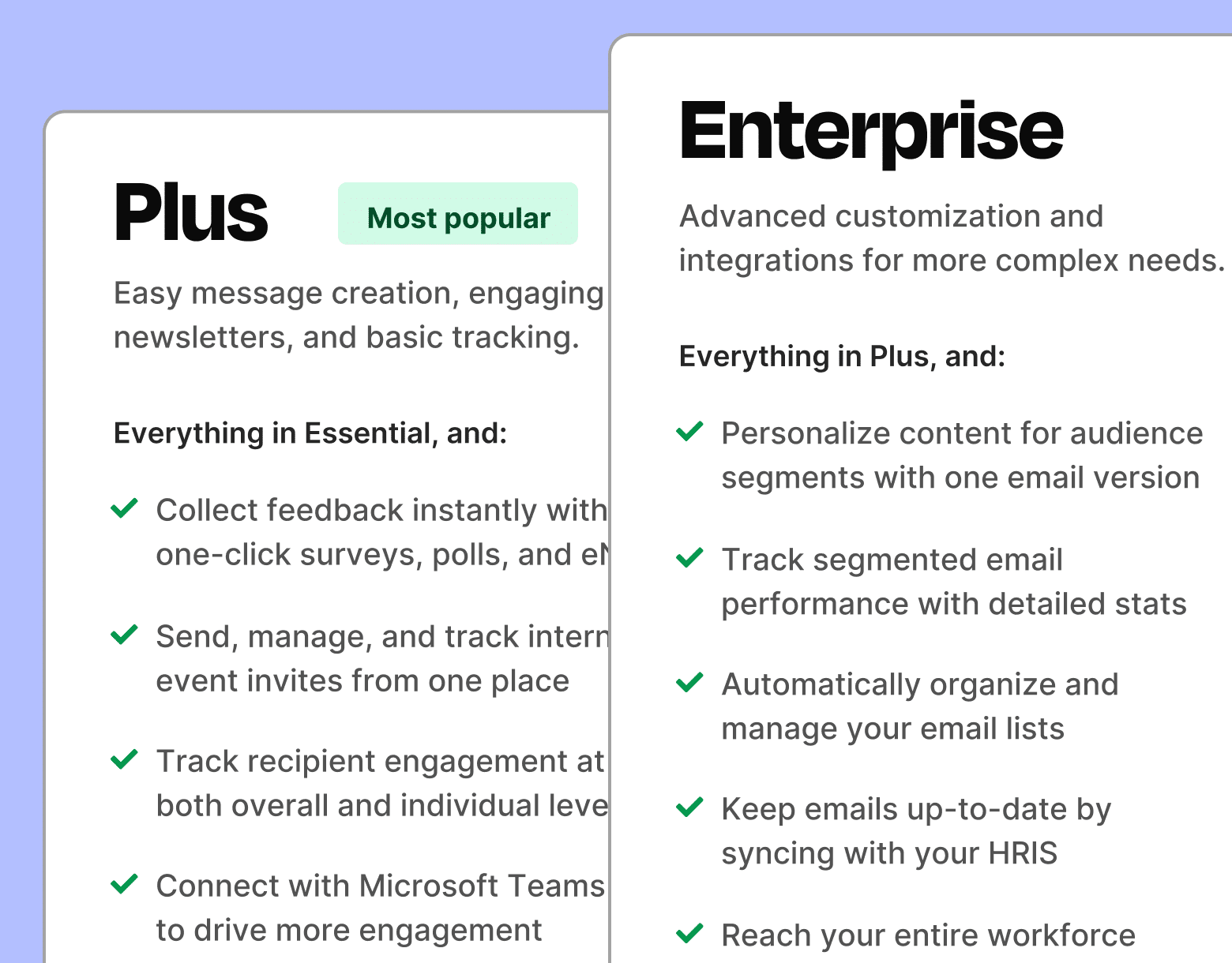
Internal Communication Metrics: Outcomes
So far we have discussed how to measure internal communications with your reach and your engagement. But we have yet to explore measuring communications effectiveness through outcomes that affect the business broadly.
While your internal communications team may not be directly responsible for brand marketing, recruiting, or customer service initiatives like chatbots or help centers, your team plays a pivotal role in enabling all of these functions. It is therefore very important to measure IC’s impact in these areas.
Employee Turnover Rate
Employee Turnover Rate is the net percentage of employees that leave a company within a certain period of time. You can measure turnover in short increments, like months or quarters, or in longer increments like years.
There are two types of turnover: voluntary and involuntary. Each type has its own set of business implications and should be looked at separately.
Voluntary turnover is when employees are choosing to quit or willingly vacate their positions. This usually happens because they are unsatisfied with their role, have a better job offer, or are looking to change their skillset or career. Because voluntary turnover is often less planned than involuntary turnover, it can cause abrupt chaos in an organization as hiring managers scramble to fill open positions.
Internal communicators should pay attention to voluntary turnover and exit interviews when strategizing ways to make an impact on the organization at a broad level. Feedback is crucial in determining how satisfied your employees are; you can make an immediate impact on employee engagement by listening and responding to feedback.
On the other hand, involuntary turnover happens when an employee is terminated or laid off. Usually, this happens because of unsatisfactory job performance, inappropriate behavior, or company downsizing.
Better training materials and culture standards can reduce the likelihood of undesirable work performance and behaviors. By investing proactively in creating a positive culture, the organization is less likely to hire the wrong fit and thereby saves time on recruiting and training potential misfits. If your organization has a high involuntary Employee Turnover Rate, it may be worth assessing a potential gap in communication somewhere in the recruiting and training processes.
Measurable behavioural outcomes from internal communications
If you’re ever trying to justify your work and wonder how to measure internal communications effectiveness of a specific medium, or you need to emphasize the impact you make on the business when negotiating for budgets, outcomes are everything, you need to understand metrics. The tricky part is that there are no standard metrics for outcomes, so you need to create your own.
First example: When introducing a new benefits platform, you might measure enrollment in a new app.
For instance, you could get 30% of employees enrolled with the first introductory email, another 25% in a followup email, but when your CEO mentions it at the quarterly town hall enrollment shoots up another 30%. You need to measure things like that so you can be more strategic with your communications.
ContactMonkey to measure internal communications
One of our clients, Exemplis, uses ContactMonkey to help with a similar problem.
According to Corey, the engagement and communications lead at Exemplis, the receptionist would email: ‘Hey, whoever left their coffee mug in the sink, please clean it and take it back to your desk.’ And it’s like, okay, that just went to 200 people.
With a team of over 1000 employees spread across multiple offices in the United States, Corey and her boss needed a way of sending out meaningful content and evaluating how employees were interacting with it. They use ContactMonkey to get pulse feedback on the adoption of new policies, as well as using it to see what areas employees crave more information.
“We’ve started to use ContactMonkey for our manager workshops. It’s a much smaller group, so we have 100% Open Rate, but the important part is seeing what links they click on. This helps our Training Manager know what material managers are searching for in between the workshops and shapes future training.“
By prioritizing communication, feedback, and engagement, the leaders at Exemplis were able to specifically assess the effectiveness of training materials and adjust the course to ensure that all training outcomes are met.
Learn how Exemplis uses ContactMonkey to get a 70% Open Rate on their weekly communication!
Core business metrics
All the metrics we mentioned above are important for measuring internal communications in the workplace, but when discussing how to measure the impact of internal communications with business leaders you need to be aware of how you are influencing their success metrics. While it’s well-known as a standalone fact that engaged employees are better performers, you want to be able to show how you are affecting those metrics.
While there are dizzying amounts of business metrics and related acronyms, here are a few key areas to watch:
- Customer Success Metrics
- Marketing Engagement Metrics
- Recruitment and Candidate Funnel
Customer success metrics
It’s no secret that happy employees make customers happier. Temkin’s 2016 Employee Engagement Benchmark Survey found that companies that excel at customer experience have 1.5x more engaged employees than companies with poor customer experience.
Customer experience metrics shouldn’t be your primary priority, but you should be able to correlate some of your internal communication with your customer experience improvements.
As an internal communicator, it is your responsibility to rally employees towards engagement. Your efforts in creating engaging newsletters and communication materials make a tangible difference in the quality of your customer service.
Marketing metrics
One of marketing’s core roles is to define the values, vision, and mission of the company—internal communications can help with this by ensuring that employees are on the same page.
At its core, internal communications is really just brand advocacy. Your brand advocates are more likely to pollinate their social media and word-of-mouth channels with positive buzz about your brand. They might share blog posts on LinkedIn, recommend your products in earnest, or even become your customers.
Don’t underestimate internal communication’s potential to help marketing increase impressions and engagement on your advertising materials.
Measuring the impact of internal communications on recruiting
Whether your business features a remote or hybrid workplace, everyone has (or is) that friend who absolutely loves their work. They’re excited to come to work every morning, they’re energetic and productive throughout the day, and the odds are good that they’re friends with their coworkers outside the office.
From a recruiting perspective, hyper-engaged employees are highly likely to refer candidates for open job postings.
Not only is it the role of internal communication professionals to cultivate these advocates and monitor them through eNPS surveys, internal communications can also help the advocates recruit their network.
Develop a Data-Based Internal Comms Strategy
We hope this guide has shed some light on how to measure communication effectiveness and given you a launchpad to get the job done. Listed above are just some of the ways internal communication professionals can start measuring communication effectiveness and have a measurable impact on multiple areas of business.
With the right internal communications measurement tools, you can get the most out of your content and staff using Outlook or Gmail. Combined with ContactMonkey’s internal email benchmarks, you’ll have what it takes to be an industry leader in internal communications.
While metrics and numbers may not be intuitively related to the art of communication, they’re still invaluable for proving the impact of soft skills in a business. If you’re trying to solidify your value in the organization, you need to measure communications to develop innovative internal communication tactics.
Have any questions about how you can start measuring internal communications metrics? Book a demo with one of our internal communications experts to show you how ContactMonkey helps you measure the impact of your internal communications.



